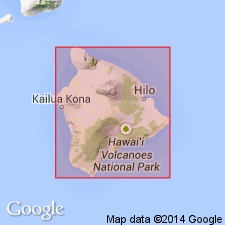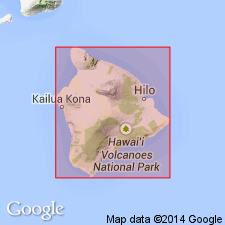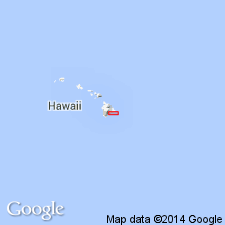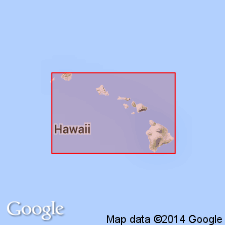
- Usage in publication:
-
- Moo Member
- Modifications:
-
- Named
- Dominant lithology:
-
- Ash
- AAPG geologic province:
-
- Hawaii
Summary:
Stratigraphic column shows unit to be youngest member of four of Hilina Formation located at Hilina Pali on southern slope of Kilauea Volcano, Island of Hawaii. Overlies Pohakaa Member (new) and underlies Pahala Formation [Pahala Ash]. Age is 30,000 yr B.P. based on projected lava accumulation rates (thesis, Easton, 1978). [Note: for name and type section information see Easton (1987)]
Source: GNU records (USGS DDS-6; Menlo GNULEX).

- Usage in publication:
-
- Moo Member
- Modifications:
-
- Overview
- AAPG geologic province:
-
- Hawaii
Summary:
Pyroclastic unit named by Easton and Garcia (1980) is youngest of Hilina Formation. Covers area of approx. 1000 sq km. Is composed of 50- to 250-cm-thick deposits of yellow-brown ash and palagonite (hydrated basaltic glass) containing some accretionary lapilli. Separated from underlying Pohakaa Member of Hilina Formation by sequence of lava flow. Age is approx. 30,000 yr B.P.
Source: GNU records (USGS DDS-6; Menlo GNULEX).

- Usage in publication:
-
- Moo Ash Member*
- Modifications:
-
- Redescribed
- Overview
- AAPG geologic province:
-
- Hawaii
Summary:
Name changed to reflect lithology and volcanic origin of this youngest member of Hilina Basalt. Named for Moo Arroyo [although this geographic feature does not appear on U.S. Kau Desert 7.5' quad topo map]. Type section at Keana Bihopa (570 m elev) (19 deg 17' 19"N, 155 deg 18' 25"W, Kau Desert 7.5' quad) [southern slope of Kilauea Volcano, Island of Hawaii, HI]. Reference section at Puu Kapukapu (19 deg 16' 45"N, 155 deg 15' 35"W, Kau Desert 7.5' quad). Measured section at Keana Bihopa with description of beds. Estimate of age is between 35 and 30 ka.
Source: GNU records (USGS DDS-6; Menlo GNULEX).

- Usage in publication:
-
- Moo Ash Member*
- Modifications:
-
- Redescribed
- AAPG geologic province:
-
- Hawaii
Summary:
Name changed to Moo Ash Member to show lithology. Formerly Moo Member of Hilina Formation (Easton and Garcia, 1980). Type locality: Keana Bihopa; reference locality: Puu Kapukapu. Assigned Pleistocene age. [see Easton, 1987, this volume]
Source: GNU records (USGS DDS-6; Menlo GNULEX).
For more information, please contact Nancy Stamm, Geologic Names Committee Secretary.
Asterisk (*) indicates published by U.S. Geological Survey authors.
"No current usage" (†) implies that a name has been abandoned or has fallen into disuse. Former usage and, if known, replacement name given in parentheses ( ).
Slash (/) indicates name conflicts with nomenclatural guidelines (CSN, 1933; ACSN, 1961, 1970; NACSN, 1983, 2005, 2021). May be explained within brackets ([ ]).

